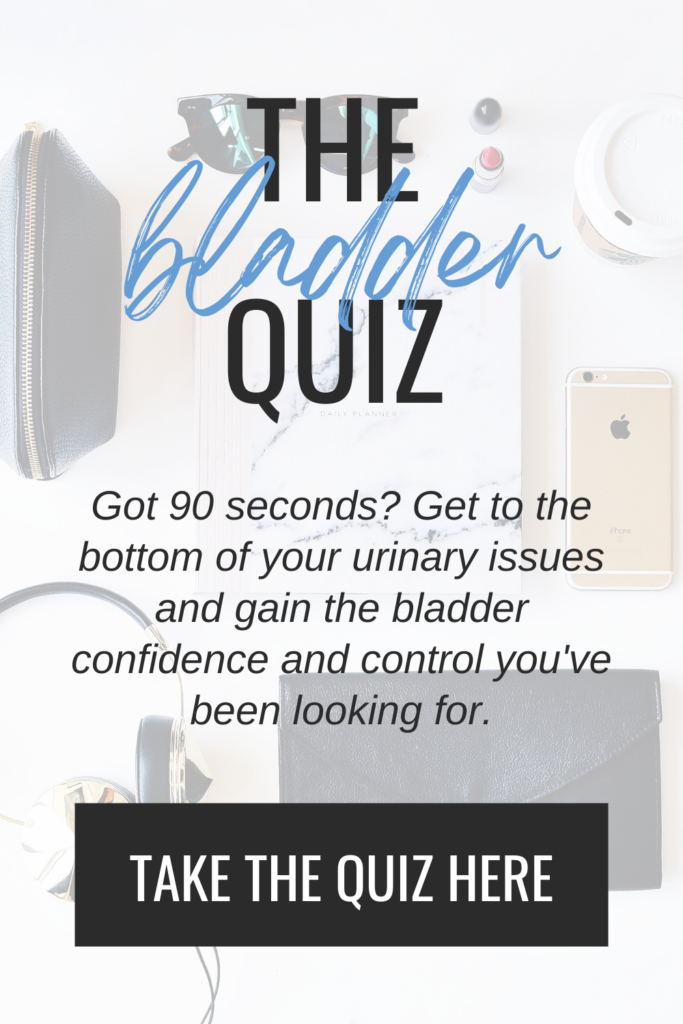We alllllll know that feeling…the non-stop urge to urinate, sudden difficulty and pain with peeing, the literal d-r-e-a-d at the thought of going to the bathroom. *Sigh*…If these things are happening you likely have a urinary tract infection (UTI), and whether this is your first one in a while or monthly/yearly infections have become your normal, you must not only treat the current issue, but also get to the bottom of why it’s happening in the first place.
Before getting to the all-natural goodness that you showed up for, it’s important to know that antibiotics are necessary depending on where your UTI is and how far it’s progressed. UTIs can take place in the kidneys, ureters, bladder, and urethra with the infection often becoming more serious the higher up the urinary tract it goes. A kidney infection will often include back pain, fever, nausea, and vomiting on top of the typical urinary symptoms and should be treated by a medical professional.
I’m all for doing what you can at home for the first few days after your symptoms start (keep scrolling for my go-to, all-natural remedies), but if the UTI doesn’t improve or worsens, it’s important for you to see a doctor.
COMMON CAUSES OF UTI
Getting to the bottom of WHY you’re getting UTIs is key to avoiding chronic or reoccurring UTIs in the future. Infections don’t just start out of nowhere— something is triggering them, and you must find the root of the problem. As you scroll through these common causes, don’t try to address all of them at once. Start at the one or two that speak to your current pelvic health situation the most, then troubleshoot through the others as needed.
1. Tight pelvic floor muscles. Despite what Cosmo Magazine may have told you, a tight pelvic floor isn’t a good thing. If the pelvic floor is tight, it becomes difficult to fully open the urethra when emptying the bladder and bacteria is more likely to grow. It’s also important to know that the pain and symptoms from a tight pelvic floor can mimic a UTI and cause similar signs of an infection without actually having a UTI at all. This is why it’s so important to get tested for a UTI prior to taking antibiotics— because you may be taking them for nothing.
How do you know if you have a tight pelvic floor? Common signs are pelvic pain, pain with intercourse, difficulty starting your urine stream, a slow urine stream, leakage after urinating, and strong urinary urge. If any of these sound like what you’re experiencing, this [FREE] guide has everything you need to begin relaxing your pelvic floor muscles today. And because the ability to relax your pelvic floor is important for all-around pelvic health, you’ll find it scattered throughout my blog too *wink wink*.
RELATED POST: My Daily Pelvic Floor Relaxing Routine + Why You Might Want to Try It Too
2. Low vaginal estrogen. Vaginal tissue depleted of estrogen becomes brittle and frail, making it more susceptible to infection and structurally unable to support the urethra. This is especially common in postmenopausal women and research shows that hormone replacement therapy with topical estrogen cream can normalize the vaginal flora and greatly reduce vaginal irritation and atrophy, and therefore decrease the occurrence of UTIs.
For a prescription estrogen I recommend Estrace (compared to other popular options like Permarin). It’s made from estradiol, the strongest form of estrogen naturally found in the human body, and is easier for our systems to process.
For an over-the counter option, the Bezwecken hydration ovals are an effective alternative I often recommend to patients. Start with half a capsule and insert it into the vagina after your last urination prior to going to bed. PRO TIP: Wear a pantiliner while sleeping as the oval will melt and leak out through the night.
Topical estrogen cream can also help postmenopausal women with general vaginal irritation, dryness, and pain with intercourse. If you’re experiencing any of the above and UTIs, this would be a great place for you to start. As always, consult your doctor prior to starting any new medication including prescription and over-the-counter hormone therapy.
3. Your vulvar care regimen. Using products that aggravate your vulva or disrupt your natural (and good) vaginal bacteria will make you more susceptible to a UTI. Common culprits are soap, lubricant, laundry detergent, and menstrual items, and if your self-care products of choice doooooon’t quite meet the recommendations I’m about to share, begin experimenting here.
- Soap- The vagina has the ability to clean itself (that’s partly why you have discharge) and introducing soap to this area can hinder your body’s ability to do so. When cleaning, you should only use your hand and warm water or the low setting on your removable showerhead.
- Lubricant- A synthetic lubricant that contains harmful chemicals is more likely to irritate your urethra and over time can lead to a UTI. Make sure to use a lubricant that’s water or silicone-based and only contains natural ingredients. For more detailed info on lubricant and my top choices, be sure to check out the blog post below.
- Laundry detergent- When it comes to caring for your vulva, how you launder your clothes plays a large role as well. Your pants and underwear sit on your vulvar skin all day, and using detergents, fabric softeners, bleach or dryer sheets that are highly toxic and full of chemicals can irritate the skin. Dryer balls instead of dryer sheets are an easy swap, and there are currently some great low or no-toxin detergents on the market that I recommend giving a try (my favorite is Norwex).
- Menstrual care- How you treat your skin during your week of menstruation can greatly effect your vulva and bladder for the rest of the month. I recommend buying 100% cotton pads or tampons to avoid harsh chemicals coming in contact with the vulvar tissue. Options like menstrual cups or softcups can be an even better alternative in regards to vulvar skin health.
For more info on how to properly care for and support your vulva and urethra, download my [FREE] guide here. Complete with a checklist for how to examine your vulva monthly, this is a must-grab if you want total bladder, urethra, and vulva health.
4. Dehydration. If you’re not drinking enough water, the contents of your bladder are going to be more acidic and the bladder will become irritated. You should aim to drink half of your body weight (in pounds) in ounces of fluid a day with two thirds of that amount being plain, pure water. This is a cheap, easy, and super effective way to keep UTIs at a minimum.
5. Constipation. Chronic constipation can place pressure on, and even obstruct, the bladder, making it difficult for the bladder to fully empty. Urine left in the bladder leads to abnormal bacteria growth and can result in regular UTIs. If you’re consistently dealing with constipation, it may be worth addressing this first. For my top tips on bowel health and becoming more regular, check out the blog post below.
6. Stress. I’m convinced that stress is a player in nearly all health issues, and UTIs are no exemption. While feeling overwhelmed is not the direct cause of an infection, chronic stress leads to higher cortisol levels, which in turn lowers the immune system and UTIs are more likely to occur.
There are many stress-regulating strategies out there including everything from breath techniques to getting outside, reading a book to speaking to someone about how you’re feeling. If you notice that you’ve been stressed more often than not, this may be something to take control of, especially if you’re having recurring UTIs.
7. Compromised gut microbiome. The bacteria in our gut can directly affect the bladder, with E. coli being the most common bacteria found in the gut, kidneys, and bladder in the presence of a UTI. Avoiding foods that you’re intolerant to can help with gut health as well as consuming probiotics through your diet and supplementation.
Make sure you’re getting a wide range of probiotics inf your diet from things like fermented foods, keifer, and yogurt. If you do choose a probiotic supplement, make sure there are at least six raw strains present including lactobacillis, which is known to help support the urinary tract.
ALL-NATURAL UTI REMEDIES
Fixing the above will help UTIs from starting in the first place, but if you have an active UTI that you want to treat naturally, it’s nice to have a few options before heading in to the doctor. All of the below should be combined with drinking plenty of water, avoiding bladder irritants like caffeine, alcohol, citrus, carbonation, spices, and artificial sweeteners, rest (when possible…my daughter doesn’t seem to understand when mama is sick) and frequent urination. Let me remind you that if a UTI isn’t getting better or is progressively worsening, it needs to be evaluated by a doctor.
1. Garlic– Garlic is known to have antimicrobial properties to help fight off UTIs. You can either consume raw garlic bulbs (do not exceed 5% of the total amount of food you eat as garlic can be toxic when consumed in large amounts) or take it as a supplement.
2. D-Mannose– E. Coli makes up 80% of all UTIs, and D-Mannose is a sugar that binds to E. Coli to help it lexit the urinary tract. This supplement also contains cranberry extract and Vitamin C (both known to help with UTIs) making it the perfect bladder-cleaning combo.
3. Bearberry– Uva Ursi leaves from the bearberry plant have antibacterial and anti-inflammatory properties and are used regularly by many countries and cultures as a natural remedy for UTIs.
Urinary tract infections, especially when more regular or chronic, can leave a person feeling frustrated, hopeless, helpless, and desperate for answers. Knowing what can be causing your UTIs and having a few all-natural options to address them is just what you need to end the vicious cycle.
I try to go the natural route as much as possible for all health issues because there are often long-term negative side effects to the harsher option. While good at killing bad gut bacteria, antibiotics are not selective in which microorganisms they kill and often destroy the good gut and vaginal bacteria leading to other health problems and more UTIs.
Knowledge is always power, and even something as “simple” as a UTI deserves the spotlight if it means less trips to the doctor, a healthier bladder, and self- empowerment. This blog post is here whenever you need it— as you first start to feel a UTI come on or for a friend who deals with this regularly. And if you know of any other must-try remedies or prevention strategies…SHARE BELOW!!! [This] is the kind of stuff women should be passing on to their besties, don’t ya think??
– Amanda
Disclaimer: The content provided here does not constitute medical advice, nor is it a substitute for personalized healthcare. If you have concerns about a medical condition, diagnosis, or treatment, you should consult with a licensed healthcare professional.
Disclosure: Some of the links above are affiliate links, meaning, at no additional cost to you, I will earn a commission if you click through and make a purchase. No pressure, but I have a feeling you’re gonna like what I’ve taken the time to put my recommendation behind.


















